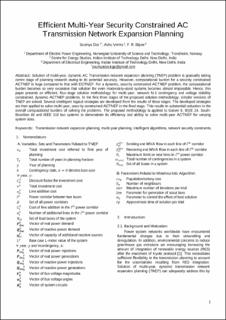| dc.contributor.author | Das, Soumya | |
| dc.contributor.author | Verma, Ashu | |
| dc.contributor.author | Bijwe, P.R. | |
| dc.date.accessioned | 2021-03-04T12:16:16Z | |
| dc.date.available | 2021-03-04T12:16:16Z | |
| dc.date.created | 2021-02-18T15:50:41Z | |
| dc.date.issued | 2020 | |
| dc.identifier.citation | Electric power systems research. 2020, 187, . | en_US |
| dc.identifier.issn | 0378-7796 | |
| dc.identifier.uri | https://hdl.handle.net/11250/2731635 | |
| dc.description.abstract | Solution of multi-year, dynamic AC Transmission Network Expansion Planning (TNEP) problem is gradually taking centre stage of planning research owing to its potential accuracy. However, computational burden for a security constrained ACTNEP is huge compared to that with DCTNEP. For a dynamic, security constrained ACTNEP problem, the computational burden becomes so very excessive that solution for even moderately-sized systems becomes almost impossible. Hence, this paper presents an efficient, four-stage solution methodology for multi-year, network N-1 contingency and voltage stability constrained, dynamic ACTNEP problems. In the first three stages of the proposed solution methodology, simpler versions of TNEP are solved. Several intelligent logical strategies are developed from the results of these stages. The developed strategies are then applied to solve multi-year, security constrained ACTNEP in the final stage. This results in substantial reduction in the overall computational burdens of solving the problems. The proposed methodology is applied to Garver 6, IEEE 24, South-Brazilian 46 and IEEE 118 bus systems to demonstrate its efficiency and ability to solve multi-year ACTNEP for varying system sizes. | en_US |
| dc.language.iso | eng | en_US |
| dc.publisher | Elsevier | en_US |
| dc.rights | Attribution-NonCommercial-NoDerivatives 4.0 Internasjonal | * |
| dc.rights.uri | http://creativecommons.org/licenses/by-nc-nd/4.0/deed.no | * |
| dc.title | Efficient multi-year security constrained ac transmission network expansion planning | en_US |
| dc.type | Peer reviewed | en_US |
| dc.type | Journal article | en_US |
| dc.description.version | acceptedVersion | en_US |
| dc.source.volume | 187 | en_US |
| dc.source.journal | Electric power systems research | en_US |
| dc.identifier.doi | 10.1016/j.epsr.2020.106507 | |
| dc.identifier.cristin | 1891461 | |
| dc.relation.project | Norges forskningsråd: 280797 | en_US |
| dc.description.localcode | © 2020. This is the authors’ accepted and refereed manuscript to the article. Locked until July10th 2022 due to copyright restrictions. This manuscript version is made available under the CC-BY-NC-ND 4.0 license http://creativecommons.org/licenses/by-nc-nd/4.0/ | en_US |
| dc.source.articlenumber | 106507 | en_US |
| cristin.ispublished | true | |
| cristin.fulltext | postprint | |
| cristin.qualitycode | 1 | |

